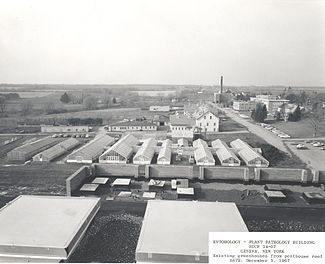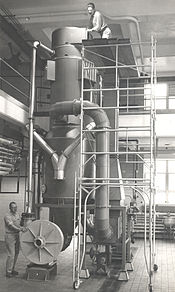- New York State Agricultural Experiment Station
-
The New York State Agricultural Experiment Station (NYSAES) at Geneva, Ontario County, New York State, is an integral part of the New York State College of Agriculture and Life Sciences at Cornell University. It is a mission-oriented experiment station with a strong emphasis on applied research. It also maintains a balance of basic research to serve as building blocks for future research applicable to New York agriculture.
Contents
History
As the sixth oldest institution of its kind in the country, the New York State Agricultural Experiment Station was established by an Act of the New York State Legislature on June 26, 1880 and became operative on March 1, 1882. More than 100 locations were considered for the site of the station, and Geneva was eventually chosen.
Originally, farmers wanted the station to serve as a model farm. However, the first director, E. Lewis Sturtevant, immediately established the policy that the station was to conduct agricultural science research and to establish experimental plots, both of which would have little resemblance to commercial agriculture. Nevertheless, the primary mission of the Station has always been to serve those who produce and consume New York's agricultural products.
In its early days, Station scientists, who were few in number, concentrated their efforts on dairy, horticulture, and evaluation of varieties of vegetables and field crops. In 1887, the program was broadened to include work on beef cattle, swine, and evaluation of fruit varieties. During this period, the station also began playing its continuing active role in the state's agricultural law enforcement program.[citation needed]
Still later, research activities were added in the fields of bacteriology, dairy science, fruit horticulture, chemistry, plant diseases, and insect and mite species.
At the beginning of the twentieth century, a fundamental philosophy was developed regarding activities of the station that is still, basically, in effect today. This philosophy stated that research done at the station should be conducted on principles underlying agricultural practices and, further, that agricultural research should be the full-time responsibility of the staff without it having to also play a teaching role. This was a marked departure from the role played by staff at other agricultural experiment stations throughout the country.
Originally an independent unit of the state, the station became part of Cornell University in 1923. Immediately, it expanded its research to include studies on canning crops, nursery plants, and disease and insect pests of rubes. At the end of World War II, all animal research was moved to the Ithaca campus of Cornell University and the Geneva Station became a true horticultural research institute. Since then, it has been the center for research in New York on the production, protection, and utilization of fruit and vegetable crops, an industry that is today valued in excess of $2 billion.[citation needed]
In 2006, two Cornell alumni endowed the Yongkeun Joh Professorship of Food Ingredient and Product Formulation, the first endowed chair to benefit the Station.[1] Amongst its innovations was the breeding of Cortland, Empire, Jonagold, Jonamac and Macoun apples.[2] The station has also developed three new wine grapes: 'Noiret', 'Corot noir' and 'Valvin Muscat' [3]
Current operations
Until rather recently, most of the money for agricultural research at the Station was provided by state and federal governments. The Station's 2007–2008 total budget is approximately $25.1 million; $11.8 million is funded through the State University of New York base budget, $6.4 million of Cornell general purpose funds, $5.5 million in grants and contracts, and $1.1 Federal appropriations.[4] As the station's research program have matured and expanded, the financial support base has been increasingly augmented by funds from foundations, industry, grower and food processor organizations, and by individuals. As of 2007, 253 staff and 50 professors (18 with at least 20% extension appointments) are employed at the Station. At any one time, 25-90 graduate students are conducting research for their theses under the guidance of professors at Geneva. At any one time, there are around 15 visiting scientists, 10 postdocs, 20 research associates and 6 extension associates at the Station.[5]
There are now four departments actively engaged in more than 120 projects. These departments are: Horticultural Sciences (study of fruit and vegetable crops, and seeds), Entomology (study of insects and mites), Plant Pathology (study of plant diseases), and Food Science and Technology (study of food processing and packaging techniques and their effects on food quality and safety). The focus is on improving the genetics, cultivation, protection, post-harvest handling, and processing of fruit and vegetable crops.
New York State is currently funding a $6.7 million construction project to renovate the Food Science laboratory.[6]
The U.S. Department of Agriculture's Plant Genetic Resources Unit, responsible for the U.S. collection of apple, cold-hardy grapes, and sour cherry as well as selected seed-propagated crops, such as onion, tomato, garlic, broccoli, cabbage and winter squash, is located on the Geneva campus.
Research
Although a mission-oriented experiment station with a strong emphasis on applied research, the station also maintains a balance of basic research to serve as building blocks for future research applicable to New York agriculture. This has been one of the fundamental guidelines of the Geneva station and a prime reason why the station and its faculty and staff are recognized worldwide as having one of the most outstanding research programs to be found anywhere. Today, its 350 employees conduct research on 230 different projects. Of these employees, 56 are professors.
The station has also grown from its original house and barns located on 130 acres (0.5 km²) of land to a complex that today includes 20 major buildings plus greenhouses and other ancillary structures. Over 700 acres (2.8 km²) of land in Geneva are devoted to test plots, orchards, and vineyards. The station also has two outlying substations: the Hudson Valley Laboratory in Highland, and the Cornell Vineyard Laboratory in Fredonia.
References
- ^ http://www.nysaes.cornell.edu/pubs/press/current/061027Joh.html Retrieved 2007-10-21.
- ^ Experiment Station unveils state's Fortune Cornell News Service 01-18-1996
- ^ http://www.nysaes.cornell.edu/pubs/press/current/060707Grapes.html Retrieved 2007-10-21.
- ^ http://www.dpb.cornell.edu/documents/1000383.pdf page 25 Retrieved 2007-10-21.
- ^ http://www.nysaes.cornell.edu/about/about.html Retrieved 2007-10-21.
- ^ http://www.dpb.cornell.edu/documents/1000383.pdf p. 81 Retrieved 2007-10-21.
External links
- New York State Agricultural Experiment Station, Geneva
- NYSAES Hudson Valley Laboratory, Highland
- Cornell Vineyard Laboratory, Fredonia
- USDA Geneva Website
Units of the State University of New York University centers Other doctoral-
granting institutionsAgriculture and Life Sciences (Cornell) • Ceramics (Alfred) • Downstate (Brooklyn) • Environmental Science and Forestry (Syracuse) • Human Ecology (Cornell) • Industrial and Labor Relations (Cornell) • Optometry (New York City) • Upstate (Syracuse) • Veterinary Medicine (Cornell)University colleges Buffalo State • Brockport • Cortland • Empire State (multi-site) • Fredonia • Geneseo • New Paltz • Old Westbury • Oneonta • Oswego • Plattsburgh • Potsdam • PurchaseTechnology colleges Alfred State • Canton • Cobleskill • Delhi • Farmingdale • Fashion Institute of Technology • Maritime • Morrisville • SUNYITCommunity colleges Adirondack • Broome • Cayuga • Clinton • Columbia-Greene • Corning • Dutchess • Erie • Finger Lakes • Fulton-Montgomery • Genesee • Herkimer • Hudson Valley • Jamestown • Jefferson • Mohawk Valley • Monroe • Nassau • Niagara • North Country • Onondaga • Orange • Rockland • Schenectady • Suffolk • Sullivan • Tompkins Cortland • Ulster • WestchesterOnline program Categories:- Cornell University
- Agriculture in New York
- Food science
- New York wine
- Education in Ontario County, New York
- Buildings and structures in Ontario County, New York
Wikimedia Foundation. 2010.


